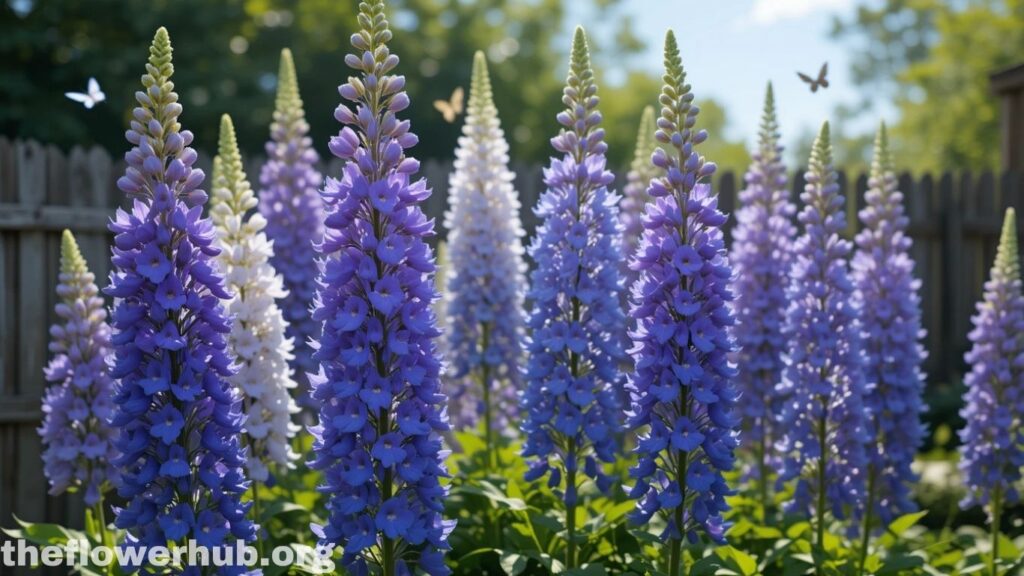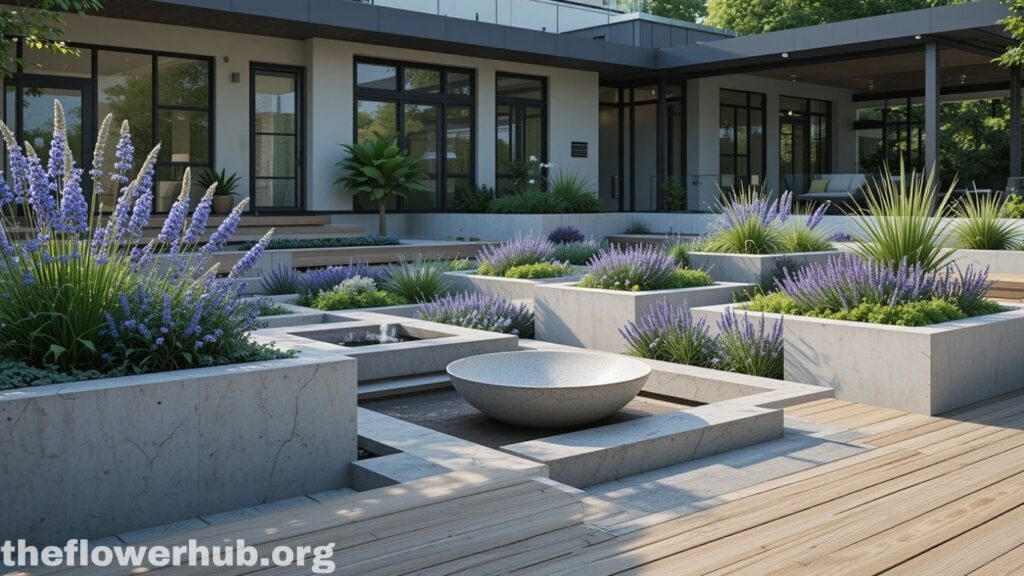Delphinium plants, known for their tall spikes of electric blue blooms, have been a favorite in cottage gardens and for flower arrangements for so long it፦s hard to say what came first! These alluring blossoms add class and grace to any floral landscape, which is why they are such popular choices in aesthetic and symbolic art, music, and culture. In this complete guide, you’ll discover intriguing facts, learn how to grow and care for it, and discover its meaning in various cultures.
What Is Delphinium?
It is a genus of about 300 species of perennial flowering plants in the family Ranunculaceae, members of which are commonly known as larkspur. The genus contains about 300 species, most of which are native to the Northern Hemisphere and high-altitude tropical Africa.

Table of Contents
Key Characteristics:
- Tall flower spikes on a well-shaped plant.
- Colors range from blue, to purple, white, pink, or occasionally yellow.
- Leaves are lobed and attractive in clumps.
- Flowers that draw bees, butterflies and hummingbirds.
It is the common dolphin-shaped buds of the flower which gave rise to the flower’s name- delphinium is Greek for “dolphin”.
7 Cool Stuff You Didn’t Know
The Secret Behind Their Stunning Blue Shades
It is also one of only a handful of flowers that truly creates blue pigment. Among gardeners who like to make a strong visual statement (and don’t prefer pastels), it is especially prized because the color isn’t common in the plant world.
Delphinium Meaning in Various Cultures
According to the language of flowers, signifies positivity, dignity and grace. Some cultures believe it provides protection from dark spirits and in others it is associated with thoughts of remembrance and good will.
A Magnet for Pollinators
Delphiniums are a banquet for pollinators. Their tall spires are full of nectar that serves to tempt the bees, butterflies, and even the hummingbirds and thus support the local ecosystem.
Toxic Beauty
Though lovely is extremely toxic when taken internally. Alkaloids are present in all parts of the wildflower and can be toxic to humans and livestock. It doesn’t keep everyone away, however, which is to be expected given its bold display in ornamental gardens.
A Staple in Cottage Gardens
Delphiniums have long been the backbone of the traditional English cottage garden. With its tall, brightly colored spikes, it provides vertical interest and marries well with roses, peonies and foxgloves.
Short Bloom, Big Impact
The blooming is mainly between early summer to early autumn, but will continue into the fall with regular deadheading. Some even offer a second flush of flowers later in the season.
A Challenge Worth the Effort
Delphinium is somewhat difficult to grow, needing rich, full sun in order to be staked adequately; they are tall plants. But the payoff is breathtaking spikes of color that can liven up any garden place.
Table
| Variety | Color | Height | Bloom Time | Special Features |
|---|---|---|---|---|
| Pacific Giant | Blue, purple, white, pink | 4-6 ft | Early summer | Ideal for borders |
| Belladonna | Sky blue, white | 3-4 ft | Midsummer | Open, airy spikes |
| Magic Fountains | Mixed | 2-3 ft | Early summer | Compact, excellent for small gardens |
| Black Knight | Deep purple | 4-6 ft | Early summer | Dramatic dark flowers |
| Summer Skies | Light blue | 4-5 ft | Early summer | Traditional cottage garden style |
How to Successfully Grow Delphinium
Location & Soil
Delphinium thrives in:
- Full sun (6+ hours: Best for plant health)
- Rich, well-drained soil
- pH slightly alkaline to about neutral
Feeding: Incorporate lots of organic matter, including compost, to improve the soil.
Planting
- Plant in the spring or early fall.
- Plants should be spaced 1 to 3 feet apart, depending on the variety.
- Carefully water after planting.
Watering & Feeding
requires:
- Regular water, especially in dry spells.
- Spring and post flowering feed with balanced fertilizer to promote subsequent blooming.
Staking & Support
Because of their height, delphiniums might require staking or plant support ring so they don’t fall over in the wind or rain.
Deadheading & Pruning
Deadhead spent spikes to encourage more flowers. Shear plants back to the ground in autumn after frost has killed the foliage.
Common Pests and Diseases
Pests
- Aphids
- Slugs and snails
- Delphinium leaf miner
Diseases
- Powdery mildew
- Black leaf spot
- Crown rot (caused by wet soil)
Tip: Many diseases can be avoided with good air circulation and correct spacing.
Delphinium in Floristry
Delphinium are popular in flower arrangements for their height and color. They bring a little drama to bouquets and are a favorite in wedding flower designs. The vase life of delphiniums can be prolonged by cutting early in the morning and standing in fresh water directly.
Cultural and Historic Value
- Delphinium was associated with an Open Heart and also became a sign of Ardent Attachment in the Victorian language of flowers.
- Delphinium dyes were used in coloring textiles by Native Americans.
- It was believed in medieval folklore that delphinium could keep scorpions and the devil at bay.
Modern Gardens
Delphinium goes in well with:

- Cottage gardens
- Mixed perennial borders
- Cutting gardens
They form tall spires to draw the visual, and add height to a gardenation, there’s no “designing” or “accenting”.
Advantages to grow
- Draws beneficial pollinators
- Adds height to garden beds
- Provides a beautiful array of colors
- Increases diversity in the landscape
FAQs
When is the best time to sow seeds?
Optimal periods are spring after the last frost, or early fall in a moderate climate.
Are Delphinium Plants Poisonous?
Yes, the whole plant is toxic if eaten and can cause skin irritation. They should also be kept out of the reach of children and pets.
Is delphinium suitable for containers?
Dwarf as well as small types (e.g., Magic Fountains) can grow well in large containers with supports provided.
How can I prolong bloom?
Remove spent blooms immediately to promote a second flower flush, offer a balanced feed, and water consistently.
Why do my keep falling down?
Their long stems that are susceptible to the wind and rain. Stake or use plant supports to keep them in place.
Are perennials and will they come back the next year?
Yes, delphinium are perennials, but may need dividing every few years to remain vigorous.
Delphiniums do best in full sun, but can tolerate some shade?
Delphiniums like full sun, although they will tolerate partial shade, but they may not bloom as well.
Conclusion
Delphiniums flowers are a beautiful addition to any garden, providing not only beauty and visual impact, but they are also beneficial to the environment. They may be a little higher maintenance compared to some other perennials, but the prize of tall spikes of colorful flowers makes it all more than worthwhile. Whether informal country gardens or formal parterres still delights gardeners everywhere.
If you’re looking to add height, color and interest to your outdoor space, might be just what you’re looking for. With tender loving care, these graceful flowers will continue to grace your garden for decades.
